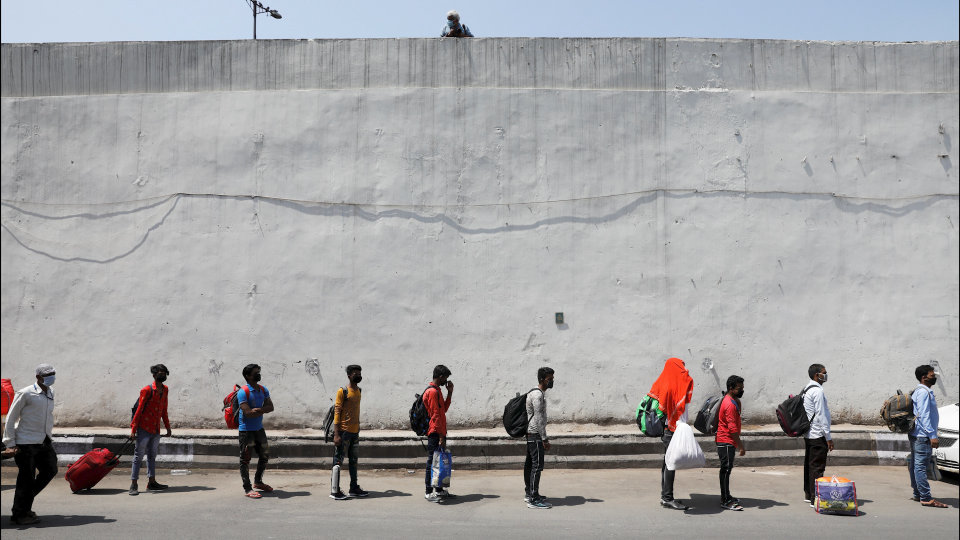Photo credit : Adnan Abidi/Reuters
Border closures and lockdown restrictions to constrain the spread of Covid-19 have impacted labour mobility significantly in South (East) Asia, both international as well as domestic labour migration1. The pandemic nature of the coronavirus crisis draws attention to cross-border labour migration; however, the challenges for domestic labour migrants are significant and perhaps the consequential burden on poverty greater. Shedding light on the experience of domestic labour migrants during the Covid-19 crisis is important to inform effective policy design and crisis relief.
The magnitude of internal migration is about 2.5 times that of international migration[1]. Migration across borders often requires high upfront costs, which many poorer households can’t afford. The remittance mechanism between domestic labour migrants and their communities is assumed to reach the most vulnerable communities in remote rural areas, providing a vital source of income.[2]
Specific issues uniquely hitting domestic migrants form critical barriers in the remittance-poverty reduction mechanism. Many of the domestic labour migrants have informal jobs, social distancing and lockdown measures have an immediate impact on the informal work economy resulting in job losses and constrain to their livelihood, which directly impacts the lifeline to households in their rural communities. Public transport disruptions are directly affecting their ability to send remittance, as the majority of domestic labour migrants remit money via informal channels by hand-carrying money and goods themselves (or through friends and relatives)[2]. Systematic barriers, including associated costs and registration issues, hinder access to formal remittance infrastructures for this group.[1]
On a social-economic dimension stigma and stress have been found to impact the choices domestic labour migrants make. In a study conducted by Rapid Asia on internal migration in Mongolia, more than half of the group of migrants involved in the study (n=519) felt that their socio-economic wellbeing had worsened amid the Covid-19 situation. Loss of income was mentioned as the most significant impact, followed by feeling depressed. In a recent opinion article, Assistant Professor of Sociology Sugandha Nagpal and Assistant Professor of Economics Vatsalya Srivastava at O.P. Jindal Global University argue that motivational behaviours for returning migrants in India’s domestic mass migration movement at the time of the national Covid-19 lockdown were often rooted in social-economic factors. They highlight the fear of stigma and care-giving burden as decision-making factors to return home.[3]
To echo the findings from Rapid Asia’s internal migration study in Mongolia, Covid-19 restrictions have impacted vulnerable groups considerably more in terms of financial hardship and stress. National policies are instrumental in safeguarding social protections for marginalized groups and vulnerable communities. Acknowledgement of the multifaceted and unique experiences of domestic labour migrants is fundamental to ensure effective crisis relief programming and access to the welfare and health system. A first important step, however, is to provide improved access to registration for temporary and permanent migrant workers in urban areas and cities and to address other policy barriers complicating access to regional public services for this group.
If you found this article useful, please remember to ‘Like’ and share on social media, and hit the ‘Follow’ button never to miss an article. You may also want to read this article: Smartphone penetration amongst migrant workers
About the authors: Daniel Lindgren is the Founder of Rapid Asia Co., Ltd., a management consultancy firm based in Bangkok that specializes in evaluations for programs, projects, social marketing campaigns and other social development initiatives. Nadine Spalburg is an independent consultant working with Rapid Asia as a member of their expert panel of consultants.
[1] World Bank. 2020. COVID-19 Crisis Through a Migration Lens. Migration and Development Brief,no. 32;. World Bank, Washington, DC. © World Bank. https://openknowledge.worldbank.org/handle/10986/33634
[2] Deshingkar, P. (2006) ‘Internal migration, poverty and development in Asia: including the excluded’, IDS Bulletin, 37(3): 88-100.
[3] Nagpal, Srivastava (2020) ‘ Long read: India’s coronavirus mass migration: How we’ve misunderstood the Indian migrant labourer. https://blogs.lse.ac.uk/southasia/2020/04/03/long-read-indias-coronavirus-mass-migration-how-weve-misunderstood-the-indian-migrant-labourer/

